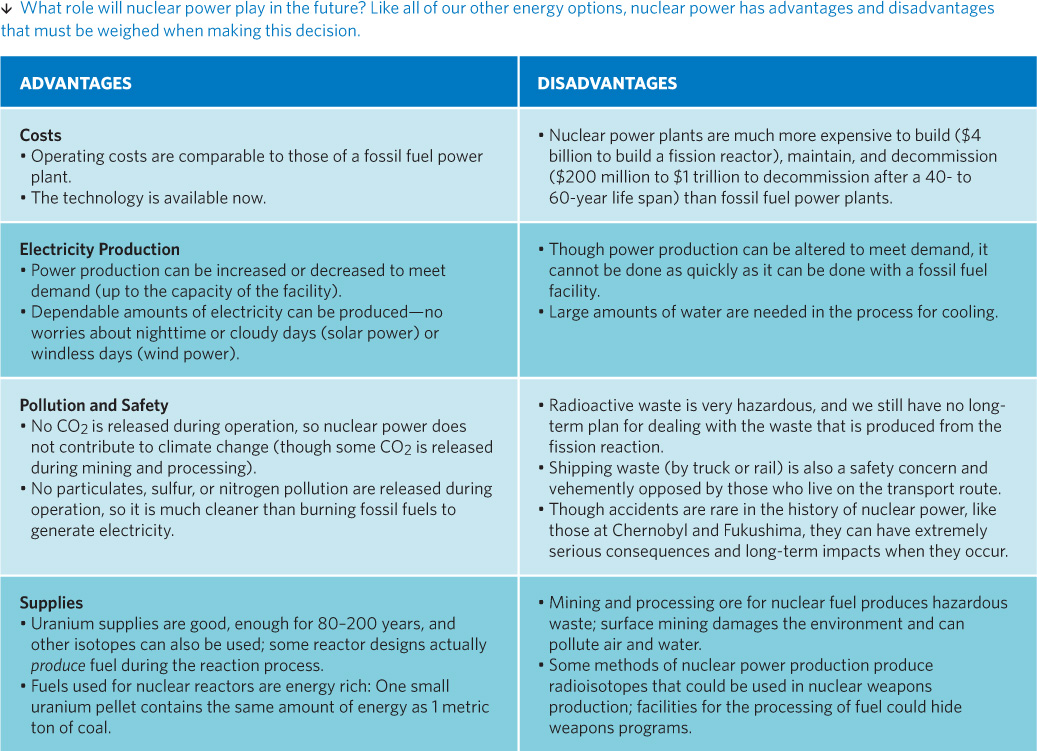Will nuclear power play a role in future energy?
The March 2011 tsunami would become the most expensive natural disaster in human history, with losses estimated at $300 billion. In its wake, countries around the world began rethinking their plans to expand their own nuclear energy programs. Germany resolved to move up the date for its planned phase-out of all nuclear power plants by 10 years, to 2022. Austria, Italy, and Switzerland also reconsidered. In the United States, however, experts fretted in a more undecided way. Critics pointed out that if the Indian Point Power Plant, 56 kilometers (35 miles) north of Times Square in New York City, necessitated the evacuation of an 80-kilometer radius (as the Daiichi plant had), it would include some 20 million people. Proponents, meanwhile, held fast to their contention that nuclear power would be an essential, unavoidable part of weaning the planet from its fossil fuel dependence. Under proper conditions, they insist, it can be a completely safe resource; the U.S. Navy, for example, has been safely using nuclear energy to power vessels since 1954, without incident.
Meanwhile, back in Japan, just 2 months after the quake and tsunami, the prime minister responded to public pressure and global criticism by calling for a temporary shutdown of one nuclear plant in the country’s center, where scientists have estimated an 87% chance of a big quake sometime in the next three decades. Other plants that were closed for routine maintenance were told to hold off on reopening so that, by summer’s end, less than one-third of Japan’s 54 reactors were still running.
KEY CONCEPT 22.8
The advantages (low air pollution, ample supplies) and disadvantages (radioactive hazards) of nuclear power must be weighed to determine whether or how much to pursue it.
In the wake of the nuclear power plant closures, Japan responded with an unprecedented campaign to reduce overall energy usage in the country. These efforts were able to replace 15% of Japan’s normal electricity use—about half of what the nuclear power plants had provided—allowing the county to avoid electricity shortfalls and blackouts.
At first the shutdowns were short-lived. Once factory owners began warning that such drastic power cuts would quickly lead to a recession, many of the deactivated nuclear power plants sprung back to life by order of the same prime minister who had closed them, only to close again after safety concerns overrode the need for power. By May 2013, no reactors were in use. To replace the lost nuclear production, Japan ramped up its fossil fuel power plants (its main source of electricity even before the disaster) to supply more than 90% of its electricity. Driven, in part, by its lack of domestic sources of fossil fuels, Japan’s government intends to resume nuclear power production after stricter safety measures are put into place. In July 2014, Sendai Nuclear Power Station became the first Japanese nuclear power plant to receive preliminary approval to start up under the country’s new, more stringent safety requirements.
Less than a year after the fires had cooled, experts would agree that the Daiichi disaster was something of a draw. “People who support nuclear energy can’t argue anymore that the risk is nonexistent,” says Powers. “But at the same time, neither can opponents say that a meltdown would automatically result in a zillion immediate casualties.”
In a paper published before the disaster at Fukushima, British nuclear engineers Robin Grimes and William Nuttall argued that nuclear power could enjoy a “renaissance” and increase its contribution to electricity production in the future, if only we improved our nuclear technology. They pointed to new “third-generation” BWR and PWR reactor designs (and others) available now, and other technologies (“fourth generation”) in development that should be safer and more efficient, producing more electricity with less fuel. Some designs also produce less of the waste material that could be used to make nuclear weapons, reducing concerns about weapons proliferation.
The third-generation designs in use today are safer, according to safety assessments, and include more failsafe responses (technical responses that automatically kick in if a problem occurs). But, of course, the 2011 earthquake and tsunami have illustrated the need to reevaluate the potential damage of natural disasters, especially with regard to siting future nuclear power plants away from potentially dangerous areas such as close to active fault lines or flood zones. The renaissance would also require better waste-handling options, including the reprocessing of spent fuel (which would decrease the waste produced and increase overall efficiency).
Given the problems associated with fossil fuels, it is likely that nuclear power will continue to have a place in our energy mix, especially with global electricity use projected to double by 2030. But in making choices about how to pursue our energy future, we must consider the costs and benefits of all our energy options. A benefit analysis must evaluate how well a particular energy source meets our energy needs. A cost analysis must consider not just the monetary cost of getting kilowatts delivered to our homes but also the environmental and social costs associated with every step of the energy source’s life, from acquisition to production to delivery to waste disposal. In addition, as mountaintop removal, oil spills, climate change, and nuclear meltdowns demonstrate, a risk assessment must also take place. We must answer two very crucial questions: How risky is the venture (an assessment we can do with at least some degree of accuracy)? and How much risk are we willing to take? TABLE 22.1


Which advantage of nuclear power do you consider to be its strongest advantage? Which of its disadvantages is its biggest detractor? Explain.
Answers will vary but should be supported.
“There is definitely a certain weighing that has to take place,” says Powers. “Global warming on one hand, nuclear accidents like Fukushima on the other.”